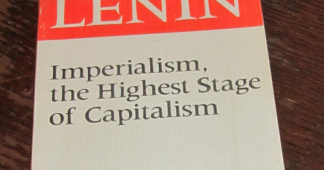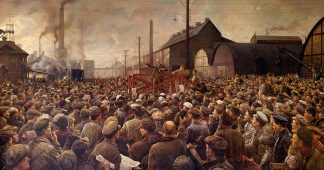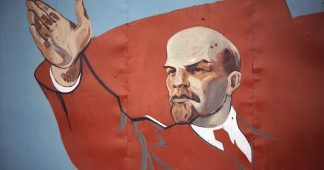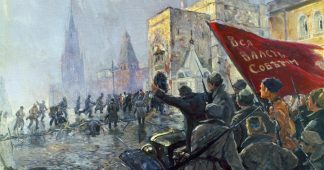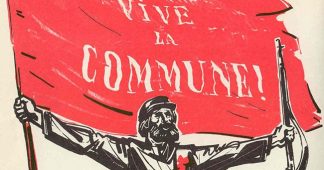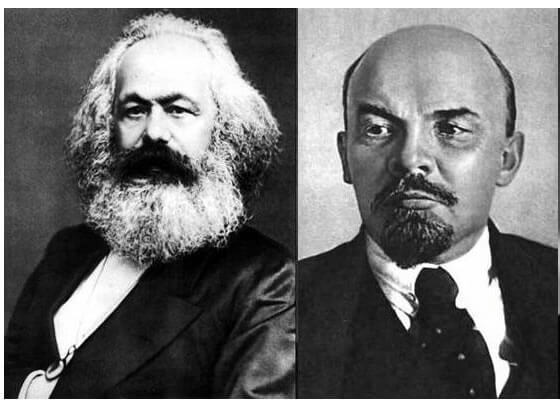Lenin and world revolution
Volume II
Review by Paul D’Amato
 Lenin’s Political Thought:
Lenin’s Political Thought:
Theory and Practice in the Democratic and Socialist Movement
By Neil Harding
Review of Vol. 2
THE SECOND half of Harding’s Lenin’s Political Thought deals with Lenin’s political life from the outbreak of the First World War to his death in 1923. This is a fitting point to pick up the thread of the story, because, as Harding argues, the outbreak of the imperialist war in 1914 marked a turning point both in the international workers’ movement and of Lenin’s political outlook.
If, in the first volume, Lenin’s analysis of Russian capitalism established the basic outlines of his political approach to the revolutionary movement in Russia, in the second volume, the collapse of the socialist international and the support of the German and French socialist parties for their respective governments’ war aims prompted Lenin to turn his attention to the question of internationalism and Russia’s role as a catalyst for world revolution.
The underlying premise of Harding’s account of Lenin, carried over from the first volume, is explained in the introduction: “to trace the relationship between theory and practice in Lenin’s political thought.” He is largely countering the Western academic view of Lenin, derived in its essentials from émigré Menshevik writers, that Lenin was “brilliant as a pragmatic politician” for whom theories acted merely as “rationalizations for actions already undertaken.”
On the contrary, argues Harding, Lenin “altered his political course only after thorough theoretical work had convinced him of the need to do so”—though Harding goes too far in another direction in claiming that for Lenin, “so much the worse for reality” if it was “out of joint with theory.” If it is true that there was strong theoretical grounding in Lenin’s actions, it is also true that he always grounded his ideas in empirical reality and was willing to alter his views when changes in Russia and the world proved them inadequate—as Harding’s own account makes clear.
Prior to the outbreak of war, Lenin had co-written, with Rosa Luxemburg and Yuri Martov, the antiwar resolution that had been passed at three consecutive congresses of the socialist international. It argued that Social Democrats should do everything in their power to prevent war, and, in the event of the outbreak of war, to use the economic and social crisis brought about by it to hasten the downfall of capitalism.
Lenin stayed true to these precepts, whereas the Social Democratic party leaderships throughout Europe did not.
What is so remarkably refreshing about Harding is that he quotes Lenin extensively, letting the reader get a good sense of what the man was actually saying; and when he paraphrases Lenin, he stands apart from most other academics in that he, in large part, gets Lenin right.
“Lenin set himself the following tasks,” Harding writes. “[D]etermine the character of the world war; assess the material basis for the collapse of the international toward ‘opportunism’ and ‘social-chauvinism,’ and three, establish a revolutionary internationalist pole of attraction around the call for the formation of a new, communist international free of opportunism, and in preparation of the anticipated revolutionary upheaval that the war would produce.”
If Lenin’s analysis of Russian capitalism was the centerpiece of his prewar analysis of the tasks of Russian socialists, Lenin’s analysis of imperialism was the cornerstone of his new perspective.
As Harding makes clear, Lenin embarked in this period on a thorough study of international capitalism and imperialism in order to nail down his position.
First, he argued that the war was a product of late capitalism—which had, in Harding’s words, “exhausted its progressive role in history.” The world war was a clash between the most powerful capitalist states—each representing the interests of highly concentrated, monopolistic industrial and financial interests—over which state would be the dominant world power. In this battle over the division and redivision of the globe, there was thus no side for the workers in each country to support. In order to drive the point home, Lenin argued that revolutionaries in the belligerent countries should wish for the defeat of their own ruling class, and he exhorted the working class to “turn the world war into a civil war.”
The war had revealed the degree to which the rot of opportunism had infected Social Democracy in the previous era of relative “peaceful” development, Lenin argued.
[T]he “all-pervading gradualism” of the second epoch (the one of yesterday) has created…an entire opportunist trend based on a definite social stratum within present-day democracy, and linked with the bourgeoisie of its own national “shade” by numerous ties of economic, social and political interests—a trend directly, openly, consciously, and systematically hostile to any idea of a “break in gradualness.”
It was necessary to break from Social Democratic reformism and form embryos of new revolutionary communist parties. This was an urgent task, in Lenin’s estimation, for two reasons. First, the development of modern capitalism in its imperialist stage had created the material conditions ripe for a transition to socialism, not only by developing the productive forces, but by socializing the means of production, and second, the horrors and deprivations of the world war would produce revolutionary situations of which revolutionaries must be prepared to take advantage.
Lenin was willing to begin with very small forces because he believed, rightly, that events would develop as he predicted. For Lenin, perhaps like no other revolutionary before or since, theory was an immediate guide to action. The imminence and necessity of revolution permeates his writings in this period leading all the way up to and through the October Revolution in Russia and beyond. For him, Russia, though too backward to establish socialism in isolation, would, by being the weak link in the chain of world imperialism, become the starting point for a socialist conflagration that would carry to Europe and the rest of the world.
Because he has set the stage so well in presenting the theoretical underpinnings of Lenin’s views, Harding’s chapter “The Art of Insurrection” is all the more satisfying in its presentation of Lenin’s carefully conceived strategic and tactical approach to revolution in Russia after the overthrow of the tsar in February 1917. He argued that the bourgeoisie would move into opposition to the revolutionary tide, that the petty-bourgeois socialist parties, the Mensheviks and Socialist Revolutionaries, would take their place and become defenders of bourgeois rule, and [in Harding’s words] “the proletariat, the army and a large part of the peasantry, would move sharply to the left and would be looking for a party which would reflect their impatient desire for resolute action, not endless talk.” Lenin based his strategy on this absolutely correct prognosis.
What’s important here is the debunking of the highly erroneous idea that Lenin favored revolution by a handful of conspirators. For Lenin, insurrection was only possible after the party, through its actions and its propaganda, had gained the support of the majority of the working class, soldiers, and poor peasants in the soviets. Lenin showed his tactical genius in his recognition of the delicate balancing act necessary in this tumultuous period of revolt— the “problem of enthusing his supporters that immediate resolute action was required to save Russia from chaos yet, at the same time, restraining precipitate action until majority support had been won over.”
The basic problem [writes Harding] was that revolutionary consciousness developed at an uneven rate. To delay too long would sap the morale of his fighting forces and dangerously expose the Bolsheviks to the attacks of activists who would maintain that the Bolsheviks, like the other talking shop parties, were mere windbags incapable of mass action. To proceed too early would, equally, alienate the mass of the people and leave the revolutionaries, even if temporarily successful, powerless before the inevitable reaction.
“Perhaps the most puzzling and inexplicable period of Lenin’s life,” Harding writes, for those who believe that Lenin was above all a practical politician, was that after the Bolshevik revolution, “instead of devoting his time to political wheeler-dealing to achieve immediate tactical advantage to his party in Russia, he concentrated his energies on an almost academic, exhaustive study of Marx and Engels on the question of the state with a view to outlining the long-term strategic objectives of the global socialist revolution.”
If Lenin’s study of imperialism was his “theoretical justification for socialist revolution,” then State and Revolution “was his attempt to establish a yardstick for socialist practice.” Most writers then and now considered this book, with its emphasis on smashing the state machine and replacing it with direct and democratic initiative of the masses, to be a departure from “Leninism. ” It is to Harding’s credit that he shows that it was the heart and soul of Lenin.
“Democracy from below,” Harding quotes Lenin, “democracy without an officialdom, without a police, without a standing army; voluntary socialist duty guaranteed by a militia formed from a universally armed people—this is a guarantee of freedom which no tsars, no swash-buckling generals, and no capitalist can take away.”
In the early phases of Bolshevik rule, Lenin’s incessant emphasis, over and over again, was on how socialism in Russia could only be consolidated on two bases—the initiative of the Russian masses themselves, and the spread of the revolution. The violent encirclement and isolation of the revolution prompted Lenin to shift his approach of necessity, with the aim of holding out until Russia could be aided by revolution in Germany. But the German revolution failed, and with it came the bureaucratic degeneration of Russia’s revolution. To his last breath, Lenin challenged the party’s degeneration. But because the working class disintegrated as a class during the civil war, and because economically backward Russia remained unaided from abroad, he was fighting against impossible odds.
The overall value of the book is only slightly marred by a handful of omissions, dubious offhanded remarks, and questionable interpretations.
For example, Harding spends far too little time on Lenin’s analysis of the national and colonial questions and his support of the right of oppressed nations to self-determination. This is an important component of Lenin’s analysis of imperialism, in particular because he linked the working-class struggles in the industrial advanced countries with the colonial rebellions in the backward countries.
In an early chapter, Harding claims that Lenin’s contention that the Social Democrats were agents of the bourgeoisie within the workers’ movement was a direct forerunner of Stalin’s Third Period line of the late 1920s and early 1930s that equated Social Democracy with fascism—a comparison that doesn’t hold water. That most European Social Democratic parties made common cause with their respective ruling classes in the world war was indisputable. That didn’t mean that Lenin, for example, equated the Russian liberals to the extreme right wing “Black Hundreds,” let alone compare the Mensheviks to them! In the early 1920s, Lenin, Trotsky, and the Communist International proposed united fronts with Social Democrats for the purposes of struggle against the employers and the far right—something that Third Period Stalinism precluded.
The most disappointing section comes in Harding’s interpretation of Lenin’s views on the state. “The utilization and huge extension of the powers of the existing state by the proletariat seems to encapsulate much of what Marx and Engels had in mind when they recommend the dictatorship of the proletariat as the state form appropriate to the newly triumphant working class,” he claims. “According to the program spelt out in the Manifesto of the Communist Party, the proletariat would utilize the coercive agencies of the state to put down its opponents…”
This is only true in the sense that whereas the Manifesto is not yet clear how the working class will take power, the Paris Commune taught them that the working class cannot seize the existing bourgeois state, but must replace it with a new, democratic form of working-class rule. From here on, their conception of the workers’ state never faltered.
Engels decisively refutes any association of the term “dictatorship of the proletariat” with seizing and strengthening the existing state in his 1891 postscript to Marx’s Civil War in France (which Harding himself quotes): “Of late, the Social-Democratic philistine has once more been filled with wholesome terror at the words: Dictatorship of the Proletariat. Well and good, gentlemen, do you want to know what this dictatorship looks like? Look at the Paris Commune. That was the Dictatorship of the Proletariat.” Harding can’t find any place that Marx called the Paris Commune the “dictatorship of the Proletariat,” and so absurdly claims that Marx and Engels parted company on this issue.
However, in 1874, three years after the Commune, Marx wrote the following in response the anarchist Bakunin, who asked: “The question arises, if the proletariat becomes the ruling class, over whom will it rule? It means that there will still remain another proletariat, which will be subject to this new domination, this new state.”
Marx responded:
It means that so long as the other classes, especially the capitalist class, still exists, so long as the proletariat struggles with it (for when it attains government power its enemies and the old organization of society have not yet vanished), it must employ forcible means, hence governmental means. It is itself still a class and the economic conditions from which the class struggle and the existence of classes derive have still not disappeared and must forcibly be either removed out of the way or transformed, this transformation process being forcibly hastened.
Marx may not use the term “dictatorship of the proletariat” here, but the meaning is clear.
It is unfortunate, then, that Harding builds on this shaky edifice the idea that in State and Revolution Lenin repeats the mistake of Engels and can’t decide which version of revolution he supports. “Lenin never resolved the problem that Engels bequeathed to him,” Harding claims.
His attempted resolution followed the lines implicit in Engels’ identification, that is he characterized the dictatorship of the proletariat, for the moment at least, in terms of the commune. There was, however, always lurking in the immediate background, an alternative model which stressed centralization against initiative from below, emphasized the need for a transitional period as against an immediate reappropriation by society of the powers arrogated by the state, and separate bodies of armed men under the guidance of the Party as against the self-activity of the people in arms.
Harding’s mental faculties temporarily break down in this section. Though he thinks he has cleverly exposed a great theoretical weakness in Lenin’s (and Marx’s) theory, what he really expresses is his own confusion over the contradictory character of the social revolution—that to abolish class distinctions and class rule, it is necessary to employ coercive methods (revolution), and if the working class wants to ensure its success, it must be willing to employ coercive, state methods to ensure the defeat also of counterrevolution after it has achieved political power.
The relationship between coercive methods from above and initiative from below is determined by the concrete features in which the revolution takes place. The tragedy in Russia was not Lenin’s confusion about state coercion versus self-activity, but the way in which the backwardness and isolation of Soviet Russia prevented that contradiction from being resolved in the direction that the revolutionaries had hoped.
These shortcomings, however, should not deter readers who are interested in developing their understanding of Lenin’s political thought from reading Harding’s otherwise excellent book
